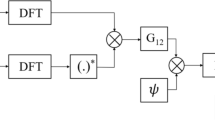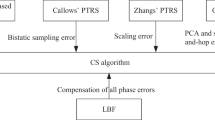Abstract
Parameter estimation is an essential step for various MIMO radar applications and attracts the attention of many scholars. However, conventional methods typically model moving objects with a constant Doppler frequency shift under Gaussian distributed noise, which may fail in a real radar electromagnetic environment. To make up for the lack of research in this field, a multi-parameter estimation scheme for bistatic MIMO radar in the presence of time-varying Doppler frequency and impulsive noise is proposed. First, a novel operator which combines the deviation from the median-based correntropy (DMCE) and fractional power spectral density (FrPSD), termed DMCE-FrPSD, is defined, and boundedness proof is given to ensure the effectiveness of the proposed methods. Afterwards, Doppler parameters are estimated by peak searching of the DMCE-FrPSD spectrogram. Furthermore, two algorithms based on DMCE-FrPSD are proposed to estimate direction-of-arrival and direction-of-departure. Compared with the existing algorithms, the proposed scheme can estimate multiple parameters with higher accuracy and lower error even under intense impulsive noise. Comprehensive Monte Carlo simulations are carried out to verify the proposed scheme’s superiority under various impulsive noise conditions.







Similar content being viewed by others
Data Availability
The data used to support the findings of this study are available from the corresponding author upon request.
References
H. Ali, S. Ahmed, M.S. Sharawi, M.S. Alouini, T.Y. Al-Naffouri, Reduced complexity DOA and DOD estimation for a single moving target in bistatic MIMO radar. Signal Process. 166, 107276 (2020)
L.B. Almeida, The fractional Fourier transform and time-frequency representations. IEEE Trans. Signal Process. 42(11), 3084–3091 (1994)
A.B. Baral, M. Torlak, Joint Doppler frequency and direction of arrival estimation for TDM MIMO automotive radars. IEEE J. Sel. Top. Signal Process. 15(4), 980–995 (2021)
I. Bekkerman, J. Tabrikian, Target detection and localization using MIMO radars and sonars. IEEE Trans. Signal Process. 54(10), 3873–3883 (2006)
E. Cardillo, A. Caddemi, A review on biomedical MIMO radars for vital sign detection and human localization. Electronics 9(9), 1497 (2020)
Y. Cheng, H. Gu, W. Su, Joint 4-D angle and Doppler shift estimation via tensor decomposition for MIMO array. IEEE Commun. Lett. 16(6), 917–920 (2012)
E. Fishler, A. Haimovich, R.S. Blum, L.J. Cimini, D. Chizhik, R.A. Valenzuela, Spatial diversity in radars—models and detection performance. IEEE Trans. Signal Process. 54(3), 823–838 (2006)
H. Gao, M. Chen, Y. Du, A. Jakobsson, Monostatic MIMO radar direction finding in impulse noise. Digit. Signal Process. 117, 103198 (2021)
J. Gong, Y. Guo, A bistatic MIMO radar angle estimation method for coherent sources in impulse noise background. Wirel. Pers. Commun. 116(4), 3567–3576 (2021)
A.M. Haimovich, R.S. Blum, L.J. Cimini, MIMO radar with widely separated antennas. IEEE Signal Process. Mag. 25(1), 116–129 (2007)
G. Hakobyan, B. Yang, High-performance automotive radar: a review of signal processing algorithms and modulation schemes. IEEE Signal Process. Mag. 36(5), 32–44 (2019)
P. Hügler, T. Grebner, C. Knill, C. Waldschmidt, UAV-borne 2-D and 3-D radar-based grid mapping. IEEE Geosci. Remote Sens. Lett. 19, 1–5 (2022)
R.J. Kozick, B.M. Sadler, Maximum-likelihood array processing in non-Gaussian noise with Gaussian mixtures. IEEE Trans. Signal Process. 48(12), 3520–3535 (2000)
J. Li, P. Stoica, MIMO radar with colocated antennas. IEEE Signal Process. Mag. 24(5), 106–114 (2007)
J. Li, P. Stoica, MIMO Radar Signal Processing (Wiley, Hoboken, 2008)
L. Li, T.S. Qiu, Joint estimation of Doppler frequency and DOA-DOD based on FRFT in bistatic MIMO radar system. J. Commun. 33(11), 171 (2012)
L. Li, T. Qiu, X. Shi, Parameter estimation based on fractional power spectrum density in bistatic MIMO radar system under impulsive noise environment. Circuits Syst. Signal Process. 35(9), 3266–3283 (2016)
L. Li, T. Qiu, A robust parameter estimation of LFM signal based on sigmoid transform under the alpha stable distribution noise. Circuits Syst. Signal Process. 38(7), 3170–3186 (2019)
T. Liu, T. Qiu, S. Luan, Cyclic correntropy: foundations and theories. IEEE Access 6, 34659–34669 (2018)
W. Liu, P.P. Pokharel, J.C. Principe, Correntropy: properties and applications in non-Gaussian signal processing. IEEE Trans. Signal Process. 55(11), 5286–5298 (2007)
S. Luan, T. Qiu, Y. Zhu, L. Yu, Cyclic correntropy and its spectrum in frequency estimation in the presence of impulsive noise. Signal Process. 120, 503–508 (2016)
X. Ma, C.L. Nikias, Parameter estimation and blind channel identification in impulsive signal environments. IEEE Trans. Signal Process. 43(12), 2884–2897 (1995)
M. Novey, T. Adali, A. Roy, A complex generalized Gaussian distribution—characterization, generation, and estimation. IEEE Trans. Signal Process. 58(3), 1427–1433 (2009)
H.M. Ozaktas, O. Arikan, M.A. Kutay, G. Bozdagt, Digital computation of the fractional Fourier transform. IEEE Trans. Signal Process. 44(9), 2141–2150 (1996)
I. Santamaría, P.P. Pokharel, J.C. Principe, Generalized correlation function: definition, properties, and application to blind equalization. IEEE Trans. Signal Process. 54(6), 2187–2197 (2006)
M. Shao, C.L. Nikias, Signal processing with fractional lower order moments: stable processes and their applications. Proc. IEEE 81(7), 986–1010 (1993)
W.G. Tang, H. Jiang, Q. Zhang, Iteratively reweighted lp norm minimization for DOD and DOA estimation in bistatic MIMO radar under impulsive noise. AEU Int. J. Electron. Commun. 153, 154263 (2022)
R. Tao, F. Zhang, Y. Wang, Fractional power spectrum. IEEE Trans. Signal Process. 56(9), 4199–4206 (2008)
Q. Tian, T. Qiu, R. Cai, DOA estimation for CD sources by complex cyclic correntropy in an impulsive noise environment. IEEE Commun. Lett. 24(5), 1015–1019 (2020)
P. Tsakalides, C.L. Nikias, Maximum likelihood localization of sources in noise modeled as a stable process. IEEE Trans. Signal Process. 43(11), 2700–2713 (1995)
J. Wu, F. Wen, J. Shi, Direction finding in bistatic MIMO radar with direction-dependent mutual coupling. IEEE Commun. Lett. 25(7), 2231–2234 (2021)
B. Xu, Y. Zhao, Z. Cheng, H. Li, A novel unitary PARAFAC method for DOD and DOA estimation in bistatic MIMO radar. Signal Process. 138, 273–279 (2017)
L. Xu, X. Zhang, Z. Xu, X. Zeng, F. Yao, Joint Doppler frequency, 2D-DOD and 2D-DOA estimation for bistatic MIMO radar in spatial coloured noise. Int. J. Electron. 102(6), 1007–1021 (2015)
Y. Xu, Z. Zheng, Joint DOD and DOA estimation for bistatic MIMO radar in the presence of unknown mutual coupling. Circuits Syst. Signal Process. 92, 1–12 (2022)
H. Yan, J. Li, G. Liao, Multitarget identification and localization using bistatic MIMO radar systems. EURASIP J. Adv. Signal Process. 2008, 1–8 (2007)
C. Yunhe, Joint estimation of angle and Doppler frequency for bistatic MIMO radar. Electron. Lett. 46(2), 170–172 (2010)
X. Zhang, L. Xu, L. Xu, D. Xu, Direction of departure (DOD) and direction of arrival (DOA) estimation in MIMO radar with reduced-dimension MUSIC. IEEE Commun. Lett. 14(12), 1161–1163 (2010)
G. Zheng, B. Chen, M. Yang, Unitary ESPRIT algorithm for bistatic MIMO radar. Electron. Lett. 48(3), 179–181 (2012)
Acknowledgements
This work is supported by the National Natural Science Foundation of China (Grant No. 61671105, 61139001, 61172108, and 61801197), the 2022 Qinglan Project of Jiangsu Universities, and the Xuzhou Science and Technology Plan Project (KC22290).
Author information
Authors and Affiliations
Corresponding author
Additional information
Publisher's Note
Springer Nature remains neutral with regard to jurisdictional claims in published maps and institutional affiliations.
Appendix A. Boundedness Proof of DMCE Under SαS Noise
Appendix A. Boundedness Proof of DMCE Under SαS Noise
The method proposed in Sect. 3 is based on DMCE. Since the second-order statistics will diverge under α-stable distributed noise, conventional second-order statistics-based methods will deteriorate seriously. Therefore, we need to prove the boundedness of DMCE to ensure the effectiveness of the proposed method.
Theorem 1
Assuming that X and Y are two i.i.d SαS random variables, the DMCE-FrPSD between X and Y is bounded.
Proof
Based on (21), we can obtain the DMCE between X and Y as
where \(m_{X} = {\text{ med}}\left( X \right)\) and \(m_{Y} = {\text{ med}}\left( Y \right)\).
It is apparent that \(XY \le \left[ {\max \left( {X,Y} \right)} \right]^{2}\). Assuming \(\left| X \right| \ge \left| Y \right|\), we can get
Substituting the characteristic function (11) into (48), we can get
where \(\int\limits_{ - \infty }^{ + \infty } {{\text{e}}^{{ - \gamma \left| \omega \right|^{\alpha } }} } {\text{d}}\omega = 2\int\limits_{0}^{ + \infty } {{\text{e}}^{{ - \gamma \omega^{\alpha } }} } {\text{d}}\omega = \frac{2}{\alpha }\gamma^{{ - \frac{1}{\alpha }}} \Gamma \left( {\frac{1}{\alpha }} \right) = h\) and \(\Gamma \left( x \right) = \int\limits_{0}^{ + \infty } {t^{x - 1} {\text{e}}^{ - t} {\text{d}}t}\) denotes the gamma function.
Then, (51) can be simplified as
If \(m_{X} \le 0\), (52) can further be expressed as
If \(m_{X} > 0\), (52) can further be expressed as
According to (53) and (54), we can infer that the DMCE between X and Y is bounded. This is the end of the proof.
Rights and permissions
Springer Nature or its licensor (e.g. a society or other partner) holds exclusive rights to this article under a publishing agreement with the author(s) or other rightsholder(s); author self-archiving of the accepted manuscript version of this article is solely governed by the terms of such publishing agreement and applicable law.
About this article
Cite this article
Dai, J., Qiu, T., Luan, S. et al. DMCE-FrPSD-Based Parameter Estimation Method for Bistatic MIMO Radar Under Alpha-Stable Distributed Noise. Circuits Syst Signal Process 42, 7250–7274 (2023). https://doi.org/10.1007/s00034-023-02435-x
Received:
Revised:
Accepted:
Published:
Issue Date:
DOI: https://doi.org/10.1007/s00034-023-02435-x




